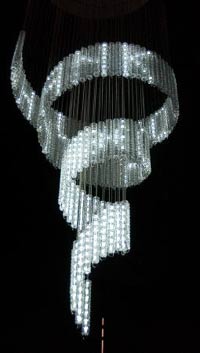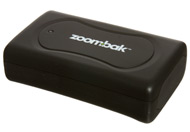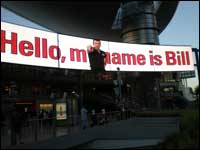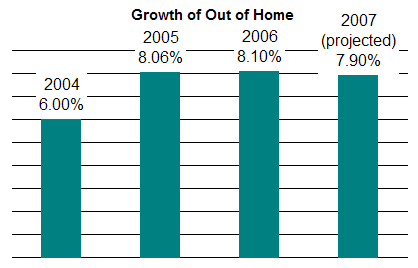Marketing technology has focused on the potential of mobile marketing for years. But it has always just been potential. Like most bloggers in my industry, I’ve written with yearning about a day when you can conduct breakthrough events or execute innovative sales strategies using cell phone GPS capabilities, and about making a mobile-oriented device such as an SMS-enabled chandelier (below) a centerpiece of your special event.
 These posts were written two years ago.
These posts were written two years ago.
So what’s the hold-up?
The chief problem is carrier barriers. Our four cellular phone carriers refuse to agree on protocols. These shared platforms would make phone bells and whistles — features that users in many other countries enjoy today — possible in this country as well.
If you’re expecting these barriers to fall soon, think again.
But in the meantime, other technology has slowly come into the reach of event marketers, and to those others like myself who grasp that the next marketing technology wave has to do with place, not a faster internet or better web agent.
Or even the unlocking of domestic cell phones!
 Meet the Zoombak
Meet the Zoombak
I’m thinking specifically now of Zoombak, a GPS device that is tiny, and cheap enough to buy in bulk and rent. It can become a way to create an unforgettable special event.
Don’t let this application as a high-tech dog tracker fool you. Here’s what Zoombak’s web copy says about this $200 device:
Our small, lightweight, water-resistant locator attaches comfortably to your dog’s collar with a durable and secure pouch. You can pinpoint your dog’s location on-demand via Zoombak.com, mobile phone (coming soon) or live customer care. You can also determine your dog’s location in real time using our continuous tracking option. Simply log on to Zoombak.com to view a map of her current location, as well as her path taken since leaving home. Once you create and activate your own customized safety zones, you can be promptly notified by text message and/or email (your choice) when your dog leaves the zone.
Imagine you’re a college recruiter, and that instead of tracking your dog, you invited a dozen participants in an exploration of your college campus. They could be on a high-tech scavenger hunt. The rest of your potential students could watch the competition on web-enabled monitors. They’d speculate on which person or team returns first with all of the requested items. (Because it’s against the law, there would of course be no wagering.)
Another example of the possibilities: Consider the popular fund-raising event of releasing dozens of rubber ducks in a river and seeing whose duck crosses the finish line first. How much more interesting would it be if, instead of a river, it was a sprawling shopping mall — or topiary maze — and instead of ducks, these where local celebrities willing to (temporarily) get themselves extremely lost for a good cause?
These are just two applications that come to mind when GPS suddenly moves within spitting distance of medium-to-large event budget.
Can you think of other applications for this?
(Thank you, David Joachim of the New York Times for getting my brain racing with an article on the Zoombak.)
 That’s why I took special note when I heard
That’s why I took special note when I heard 